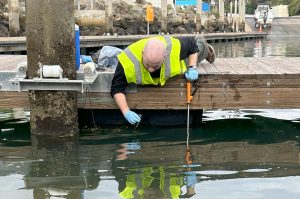Bight ’23 wraps up shellfish field sampling

The Southern California Bight 2023 Regional Monitoring Program has completed field sampling for an ongoing investigation into how multiple types of contaminants accumulate in shellfish – a highly leveraged effort that will generate insights benefitting four Bight ’23 study elements.
Field work for the Bight ’23 shellfish assessment, which was completed in September, involved sampling at 31 coastal sites to measure the degree to which legacy contaminants, PFAS (per- and polyfluoroalkyl substances), toxins produced by harmful algal blooms (HABs), microplastics, and pathogens are accumulating in the tissues of oysters and mussels. Samples were collected during the winter, spring and fall to capture a range of exposure conditions and pathways in the Bight.
Via this study, four separate Bight ’23 study elements that have traditionally operated mostly in silos – Sediment Quality, Harmful Algal Blooms, Trash and Microplastics, and Microbiology – are working collaboratively to oversee and manage the shellfish assessment, making it a uniquely cross-cutting Bight ’23 investigation.
The next step is to analyze the shellfish tissue for contaminants, which is expected to take about 1-1/2 years.
More news related to: Emerging Contaminants, Regional Monitoring, Southern California Bight Regional Monitoring Program, Trash Pollution